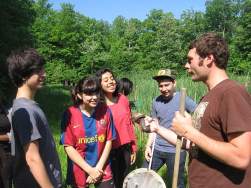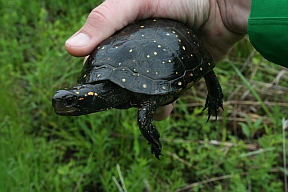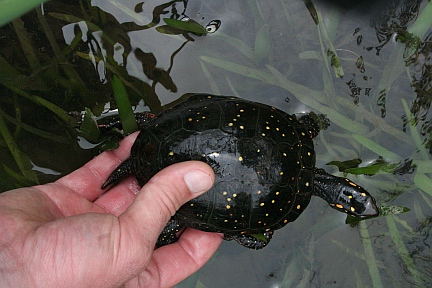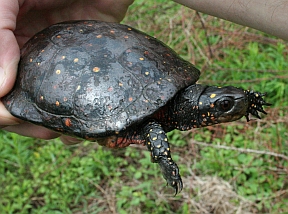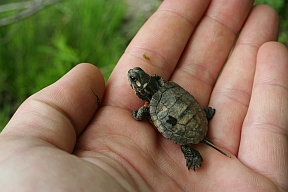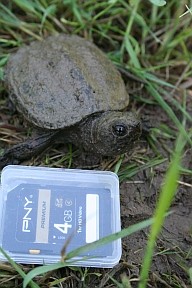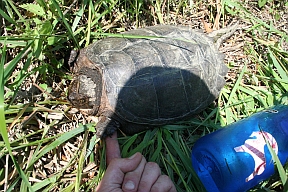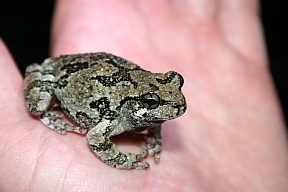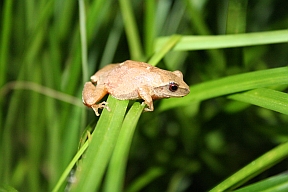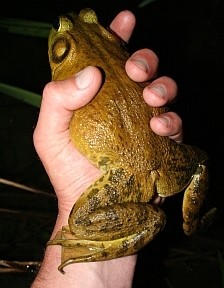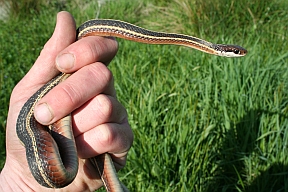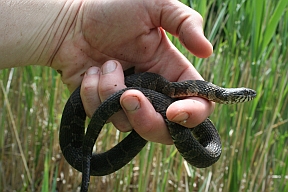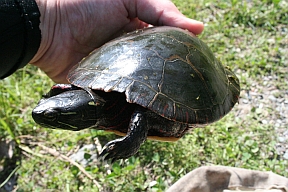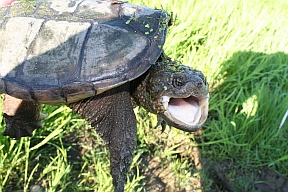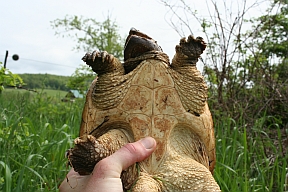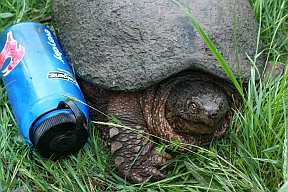Hi, my name is Benjamin Derr. I am a student from SUNY Cobleskill who is studying Wildlife Management, and a 2013 spring/summer Farmscape Ecology intern. The rising spring temperatures have caused the annual emergence of our local cold blooded friends. Below, I’ll take a closer look at these ancient creatures of our local ponds, wet meadows, forests, and fields.
Spotted Turtle Surveys
Spotted turtles (Clemmys guttata) are listed as a species of special concern in New York State. It may take up to 10 years for this species to become sexually mature, and these turtles can live to be over 50 years of age. With each individual having a unique spotting pattern, detailed pictures were taken and closely examined in order to estimate how many of these turtles were in our study area. Carapace (top portion of shell) length and sex was recorded to further identify individual specimens.
Eight surveys conducted within a 3 week period, revealed 12 individual spotted turtles living in the selected area. Four turtles were recaptured and easily identified by spotting patterns, or shell injury. One specific turtle, nicknamed “7″ was recaptured 5 times. Although only 12 spotted turtles were found, more could occur, but, based on recapture rates, the population probably does not exceed 20 in the survey area.
While working with nature, one becomes more aware of individual species’ personalities. The spotted turtle is a small, semi aquatic reptile, who is often not shy of its handler. While being captured, these turtles became energetic, and were tricky to measure and photograph at times. Spotted turtles have beautiful shells, are fun to observe and have a different behavior than other turtles I have previously watched. Clemmys guttata are yet another gem found in the natural world that I am happy to have worked with and further learned about.
Non-Target species observed while conducting spotted turtle surveys
Night frog surveys
During mating season, certain Anuran species are much easier to observe at night because they congregate in large numbers. Grey tree frogs (Hyla versicolor) are arboreal species who descend from trees to mate in the late spring. Due to their cryptic coloration and selected habitat in trees, these frogs are hard to find, observe, and photograph. Two warm nights in May were spent searching the Hawthorne Valley fire pond for grey tree frogs and other frog species. Most effort was spent observing grey tree frogs, bullfrogs (Rana catesbeiana) , and spring peepers (Pseudacris crucifer), while green frogs (Rana clamitans) where only observed and not photographed.
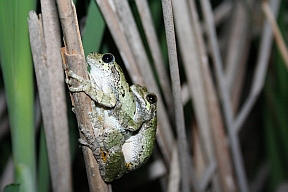
Grey tree frogs mating in a pose referred to as amplexus, where the male hugs the female from behind.
Spring peepers mate much earlier in the spring than the gray tree frog and can be observed on nights when temperatures rise over 40 degrees. Spring peepers are easily identified by a dark “x” pattern on their back, and by their signature vocalization.
The bullfrog is North America’s largest anuran species. Reaching lengths over 8 inches, this frog is known to eat just about anything that fits in its mouth, occasionally including small rodents and birds. Tadpoles from the bullfrog may take up to 4 years to completely metamorphose into a bullfrog, and overwinter at least 1 year as a tadpole. Smaller adult individuals may resemble green frogs, but can be identified by the absence of a lateral ridge, resulting in a smooth back. The bullfrog also has a deep vocalization, unlike the green frog.
Other findings on the farm

Green frog found along a cow path at the farm. Presence of dorsal lateral ridges help positively distinguish green frogs from bullfrogs.
Green frogs are among the most common frogs found in New York. This species inhabits almost any area that provides some moisture and cover, including ponds, wetlands, streams, and fields. Green frogs can be distinguished from bullfrogs by their pair of dorsal lateral ridges, which runs from the eye, pass the tympanum (simple ear), and along their back.
The ribbon snake (Thamnophis sauritus) is a member of the garter snake genus and is usually found near a wet area. The snake has the ability to shed its tail when in danger, and while the snake finds safety, its shed tail will squirm and move attracting the predator. This snake however cannot regenerate its tail, so this defense can only be used once. The ribbon snake is also ovoviviparous, meaning it gives birth to live young, but does not provide placental nourishment.
Northern water snakes (Nerodia sipedon) are wide-spread in New York and can be found near most bodies of water and wetlands. They feed on a wide variety of aquatic prey including fish, frogs, salamanders, birds, and mammals. They are non-venomous, harmless, and will dart away from most human activity. Females do not lay eggs like most snakes, but give birth to live young, called ovoviviparity.
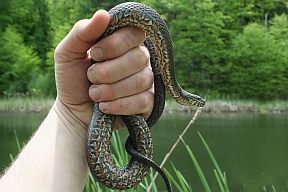
Underside view of northern water snake, caught at the fire pond. Like many other species of wildlife, there is color variation among individuals.
Painted turtles (Chrysemys picta) are the most common and well known of the turtle species in New York State. They can live up to 30 years in the wild, and are seen basking on logs, on top of vegetation, crossing roads, and laying eggs. When picked up, these individuals can be quite shy. They often retreat into their shell and excrete a urine/ feces mixture on the handler. When disturbed, while basking, these turtles waste no time “rocketing” into the water.
With most turtles having to bask, an adult male snapping turtle (Chelydra serpentina) may never leave a body of water if all needs are met. Females are often seen crossing roads to lay eggs, or males can be found traveling to find a mate. When disturbed, these prehistoric looking animals will secrete an odor, unpleasant to most. The average life expectancy is thought to be 30 years, with individuals certainly living longer. Snapping turtles eat just about anything they find, including carrion. Snapping turtles also eat a large amount of aquatic vegetation.
Snapping turtles have a plastron (bottom portion of shell) that leaves much of their underside exposed. Coupled with a head too large to fully withdraw into their shell, they have evolved to be aggressive in order to survive. Snapping turtles are fairly docile in the water, and will retreat quickly from danger, but when approached or disturbed on land, their common name is fully enforced.
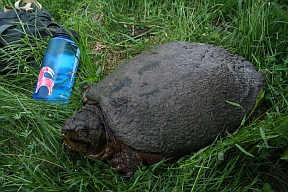
Large snapping turtle with a 1L nalgene bottle for size reference. Some snapping turtles get so large and heavy that injury can occur to the specimen being handled. Never hold an adult snapping turtle by the tail, for this can cause dislocation.
The older a common snapping turtle is, the smoother the shell will be. Younger specimens will have keeled scutes (raised scales). It is dangerous to handle large snapping turtles, for injury could result for both handler and turtle. Although snapping turtles seem to be impenetrable “tanks” of the wild , they are still vulnerable to injury from mishandling. Sometimes it is better to observe nature without interference.

